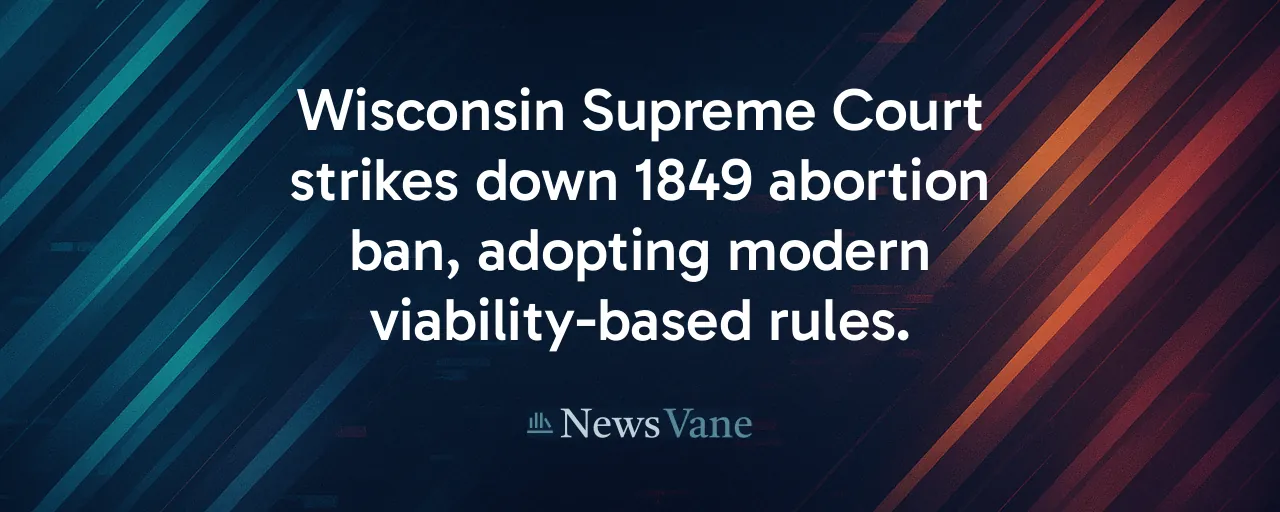A Historic Shift in Wisconsin's Abortion Landscape
On July 2, 2025, Wisconsin's Supreme Court delivered a landmark decision, striking down a 176-year-old law that had cast a shadow over abortion access. The 1849 statute, which banned nearly all abortions, was deemed obsolete by the court's liberal majority. Modern regulations, including a viability-based framework, now govern abortion care in the state. This ruling marks a pivotal moment, resolving years of legal uncertainty sparked by the U.S. Supreme Court's 2022 decision to overturn Roe v. Wade.
The debate over abortion in Wisconsin has long been a lightning rod, pitting personal autonomy against deeply held ethical concerns. When Roe fell, some prosecutors argued the 1849 ban had roared back to life, prompting clinics to halt services. Patients faced chaos, with many traveling out of state for care. The court's decision offers clarity but opens new questions about how Wisconsin can balance competing priorities in a polarized era.
Why the Old Law Fell
The Wisconsin Supreme Court, now with a 4-3 liberal majority, ruled that the 1849 law no longer applies to consensual abortions. Justices pointed to a web of modern statutes, enacted since 1985, that regulate abortion with precision, from waiting periods to facility standards. These newer laws, the court argued, effectively replaced the outdated ban, a legal concept known as implied repeal. This reasoning sidestepped constitutional questions, focusing instead on statutory conflict.
Attorney General Josh Kaul, who challenged the ban, hailed the decision as a victory for clarity. Sheboygan County District Attorney Joel Urmanski, who defended the 1849 law, warned it could weaken legislative authority. Legal scholars note the ruling hinges on a cautious but established doctrine, though some question its broad application. For now, abortions remain legal up to fetal viability, roughly 20 to 22 weeks, with exceptions for life or health risks.
The Human and Economic Stakes
Beyond the courtroom, the ruling reshapes lives. Medical studies show strict abortion bans increase maternal health risks, particularly for low-income and rural women. When Wisconsin clinics paused services after Roe's fall, patients faced delays, higher costs, and, in some cases, complications. Restoring access eases these burdens, allowing in-state care and reducing travel expenses. Economists also link abortion access to higher earnings and education for women, signaling broader societal impacts.
The decision carries economic weight for clinics, insurers, and employers. Planned Parenthood of Wisconsin and other providers can now operate with greater certainty, while businesses may see workforce benefits as employees avoid out-of-state travel. The ruling fuels political spending, with millions already poured into court elections and advocacy campaigns. As both sides gear up for the 2026 midterms, abortion remains a galvanizing force.
Navigating a Fractured Debate
Wisconsin's abortion debate reflects a broader national divide. Advocates for access emphasize bodily autonomy and public health, citing data showing majority support for legal abortion in most cases. Those prioritizing fetal protection argue the 1849 law's intent remains valid, backed by polls favoring gestational limits. Both sides draw on history: the 1849 ban emerged in an era without women's suffrage, while modern laws reflect decades of legislative compromise.
Medical associations, including the Wisconsin Medical Society, warn that restrictive laws disrupt standard care, from miscarriage management to emergency interventions. Legal experts highlight the confusion caused by overlapping regulations, a problem the ruling seeks to address. With a GOP-led legislature and Democratic governor, new laws face gridlock, leaving courts as the primary battleground.
Finding Common Ground
Amid the clash, opportunities for compromise exist. Maintaining the viability threshold, around 20 weeks, aligns with current law and public sentiment. Explicit exceptions for cases of sexual assault or medical emergencies could bridge gaps, protecting clinicians and patients alike. Expanding prenatal and postpartum support, alongside contraception access, addresses shared goals of reducing unintended pregnancies and supporting families.
A bipartisan legislative study could modernize Wisconsin's reproductive health laws, untangling outdated statutes. Reforming judicial selection, such as merit-based systems, might cool partisan court battles. These steps prioritize practical solutions over ideological wins, offering a path to stability in a contentious arena.
What Lies Ahead
The Wisconsin Supreme Court's ruling settles one question but sparks others. Clinics must still navigate a 24-hour waiting period, mandatory ultrasounds, and physician-only rules, which critics say limit access, especially in rural areas. Telemedicine for medication abortions remains a gray zone, and provider shortages persist. Meanwhile, the legislature could revisit restrictions if political winds shift.
The decision's legal ripple effects are significant. It strengthens implied-repeal arguments, potentially influencing other states. Questions linger about whether Wisconsin's constitution offers stronger abortion protections than federal law, a matter future courts may tackle. For now, the ruling empowers patients and providers but guarantees ongoing debate.
Wisconsin stands at a crossroads. By prioritizing clear laws, equitable access, and shared priorities like maternal health and family support, the state can chart a course that respects diverse views. The path demands collaboration, not confrontation, to ensure policies reflect the needs of all its people.
